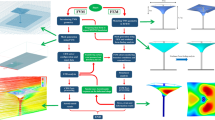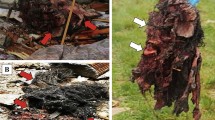Abstract
Since the 1970s, there has been an increased interest in the use and development of less lethal kinetic energy (LLKE) projectiles. These weapons are mainly used by law enforcement officers worldwide in cases of riot and crowd control. Even if such projectiles are designed to incapacitate an individual with a low risk of serious injuries, the literature indicates a risk of thorax injuries like rib fractures and lung and heart contusions when a projectile strikes the body. Among published articles discussing the wounding potential of LLKE projectiles, two are particularly well documented describing two field cases involving deformable projectiles (eXact iMpact™ and Flash-Ball®). However, one question remains: how to properly exploit field cases in order to find both injury thresholds and guidelines for the design of LLKE projectiles? Hence, the authors focus their research on the use of numerical tools as the finite element (FE) method to recreate the real impact conditions on a biofidelic human torso FE model. It requires the accurate modeling of the deformable projectiles at dynamic strain rates. To address that issue, the study begins by several ballistic experiments on a rigid wall equipped with a load sensor and a high-speed camera. The impact force measured and high-speed images are directly used in an inverse procedure to optimize model parameters of the concerned projectile to correlate impact experiments and modeling. Finally, this is followed by the impact modeling on the human torso FE model and the identification of model-dependent numerical metrics suitable to predict lung and heart contusions. While efforts need to be pursued, this present research provides an interesting step towards designing effective and reliable LLKE projectiles.


















Similar content being viewed by others
References
de Brito D, Challoner KR, Sehgal A, Mallon W (Oct. 2001) The injury pattern of a new law enforcement weapon: the police bean bag. Ann Emerg Med 38(4):383–390
Kobayashi M, Mellen PF (Sep. 2009) Rubber bullet injury: case report with autopsy observation and literature review. Am J Forensic Med Pathol 30(3):262–267
Ritchie AJ (1992) Plastic bullets: significant risk of serious injury above the diaphragm. Injury 23(4):265–266
Wahl P, Schreyer N, Yersin B (Oct. 2006) Injury pattern of the Flash-Ball®, a less-lethal weapon used for law enforcement: report of two cases and review of the literature. J Emerg Med 31(3):325–330
Suyama J, Panagos PD, Sztajnkrycer MD, FitzGerald DJ, Barnes D (2003) Injury patterns related to use of less-lethal weapons during a period of civil unrest. The Journal of Emergency Medicine 25(2):219–227
Bir C, Viano D, King A (2004) Development of biomechanical response corridors of the thorax to blunt ballistic impacts. J Biomech 37(1):73–79
Bir C, Viano DC (Dec. 2004) Design and injury assessment criteria for blunt ballistic impacts. J Trauma 57(6):1218–1224
Prat N, Rongieras F, de Freminville H, Magnan P, Debord E, Fusai T, Destombe C, Sarron JC, Voiglio EJ (2012) Comparison of thoracic wall behavior in large animals and human cadavers submitted to an identical ballistic blunt thoracic trauma. Forensic Sci Int 222(1–3):179–185
Pavier J, Langlet A, Eches N, Prat N, Bailly P, Jacquet J-F (2015) Experimental study of the coupling parameters influencing the terminal effects of thoracic blunt ballistic impacts. Forensic Sci Int 252:39–51
Bresson F, Ducouret J, Peyré J, Maréchal C, Delille R, Colard T, Demondion X (2012) Experimental study of the expansion dynamic of 9mm Parabellum hollow point projectiles in ballistic gelatin. Forensic Sci Int 219(1–3):113–118
Luo S, Xu C, Chen A, Zhang X (2016) Experimental investigation of the response of gelatine behind the soft body armor. Forensic Sci Int 266:8–13
Bracq A, Haugou G, Delille R, Lauro F, Roth S, Mauzac O (2017) Experimental study of the strain rate dependence of a synthetic gel for ballistic blunt trauma assessment. J Mech Behav Biomed Mater 72:138–147
Bracq A (2018) “Towards the prediction of thoracic injuries during blunt ballistic impacts through experimental and numerical approaches,” Thesis, Université de Valenciennes et du Hainaut-Cambresis
Gayzik FS, Moreno DP, Vavalle NA, Rhyne AC, Stitzel JD (2011) Development of the global human body models consortium mid-sized male full body model. In: Injury Biomechanics Research, Proceedings of the Thirty-Ninth International Workshop
Shigeta K, Kitagawa Y, Yasuki T (2009) Development of next generation human FE model capable of organ injury prediction. In: Enhanced Safety of Vehicle Conference, Stuttgart, Germany, pp. 15–18
Kang J, Chen J, Dong P, Liu H, Zhang Q (2012) Numerical simulation of human torso dynamics under non-penetrating ballistic impact on soft armor. Int J Dig Content Technol Appl 6(22):843–850
Roberts JC, Merkle AC, Biermann PJ, Ward EE, Carkhuff BG, Cain RP, O’Connor JV (2007) Computational and experimental models of the human torso for non-penetrating ballistic impact. J Biomech 40(1):125–136
Roth S, Torres F, Feuerstein P, Thoral-Pierre K (2013) Anthropometric dependence of the response of a thorax FE model under high speed loading: validation and real world accident replication. Comput Methods Prog Biomed 110(2):160–170
Bodo M, Bracq A, Delille R, Marechal C, Roth S (2017) Thorax injury criteria assessment through non-lethal impact using an enhanced biomechanical model. J Mech Med Biol 1–17
Awoukeng Goumtcha A, Bodo M, Taddei L, Roth S (2016) From military to civil loadings: preliminary numerical-based thorax injury criteria investigations: thoracic injury criteria from numerical study of real-world accident. Int J Numer Methods Biomed Eng 32(3):1–14
Nsiampa N, Robbe C, Papy A (2018) Non-lethal projectile characterisation method: application to 40-mm SIR-X and condor NT901 projectiles. Human Factors and Mechanical Engineering for Defense and Safety 2(1):7
Taylor G (1948) The use of flat-ended projectiles for determining dynamic yield stress I. Theoretical considerations. Proc R Soc Lond A Math Phys Sci 194(1038):289–299
Bracq A, Haugou G, Bourel B, Delille R, Maréchal C, Lauro F, Roth S, Mauzac O (2018) Characterization of a visco-hyperelastic synthetic gel for ballistic impacts assessment. In: Kimberley J, Lamberson L, Mates S (eds) Dynamic Behavior of Materials, Volume 1: Proceedings of the 2017 Annual Conference on Experimental and Applied Mechanics. Springer International Publishing, Cham, pp 109–113
Bracq A, Haugou G, Bourel B, Maréchal C, Lauro F, Roth S, Mauzac O (2018) On the modeling of a visco-hyperelastic polymer gel under blunt ballistic impacts. Int J Impact Eng 118:78–90
Bracq A, Haugou G, Morvan H (2019) Constitutive modeling of polyamide split Hopkinson pressure bars for the design of a pre-stretched apparatus. In: Kimberley J, Lamberson LE, Mates S (eds) Dynamic behavior of materials, vol 1. Springer International Publishing, Cham, pp 201–205
Kolsky H (1949) An investigation of the mechanical properties of materials at very high rates of loading. Proc Phys Soc Sect B 62(11):676–700
Storåkers B (1986) On material representation and constitutive branching in finite compressible elasticity. J Mech Phys Solids 34(2):125–145
Prat N, Rongieras F, Voiglio E, Magnan P, Destombe C, Debord E, Barbillon F, Fusai T, Sarron JC (2010) Intrathoracic pressure impulse predicts pulmonary contusion volume in ballistic blunt thoracic trauma. J Trauma 69(4):749–755
Greer A, Cronin D, Salisbury C, Williams K (2005) Finite element modeling for the prediction of blast trauma. In: Gilchrist MD (ed) IUTAM Symposium on Impact Biomechanics: From Fundamental Insights to Applications, vol 124. Springer-Verlag, Berlin/Heidelberg, pp 263–271
Bouamoul A, Williams K (2010) Effect of uman and sheep lung orientation on primary blast injury induced by single blast. In: Personal Armour Systems Symposium. Québec, Canada, pp. 149–156
Funding
This research is funded by the French Ministry of the Interior and is carried out within the framework of the CNRS Research Federation on Ground Transports and Mobility, in articulation with the ELSAT2020 project supported by the European Community, the French Ministry of Higher Education and Research, the Hauts de France Regional Council, and the AIP-Primeca Nord-Pas de Calais group. The authors gratefully acknowledge the support of these institutions.
Author information
Authors and Affiliations
Corresponding author
Additional information
Publisher’s Note
Springer Nature remains neutral with regard to jurisdictional claims in published maps and institutional affiliations.
Rights and permissions
About this article
Cite this article
Bracq, A., Delille, R., Bourel, B. et al. Numerical Recreation of Field Cases on a Biofidelic Human FE Model Involving Deformable Less-Lethal Projectiles. Hum Factors Mech Eng Def Saf 3, 5 (2019). https://doi.org/10.1007/s41314-019-0022-8
Received:
Revised:
Accepted:
Published:
DOI: https://doi.org/10.1007/s41314-019-0022-8




